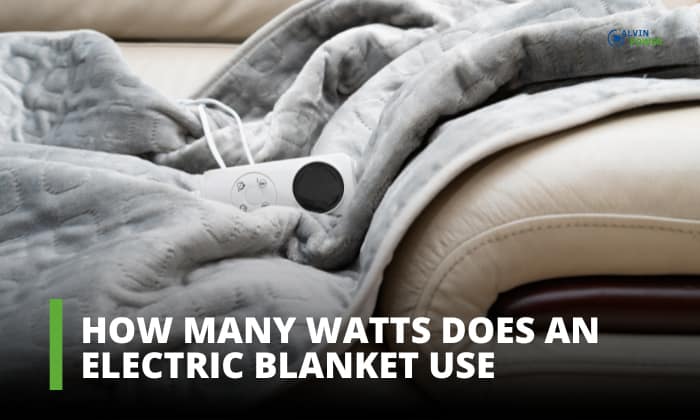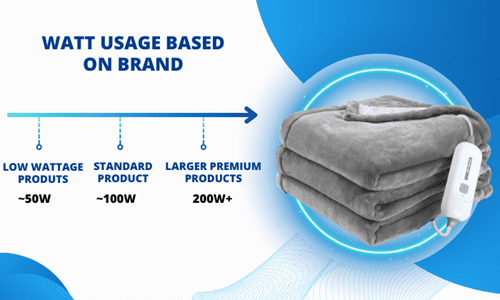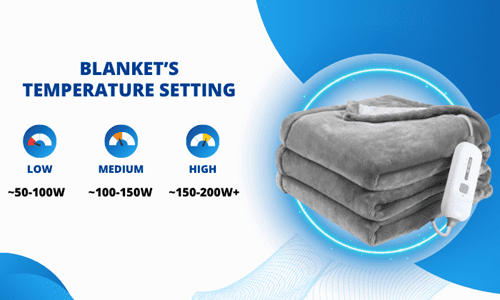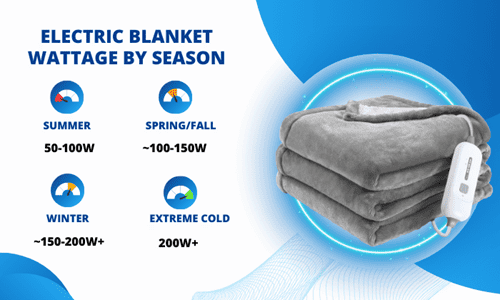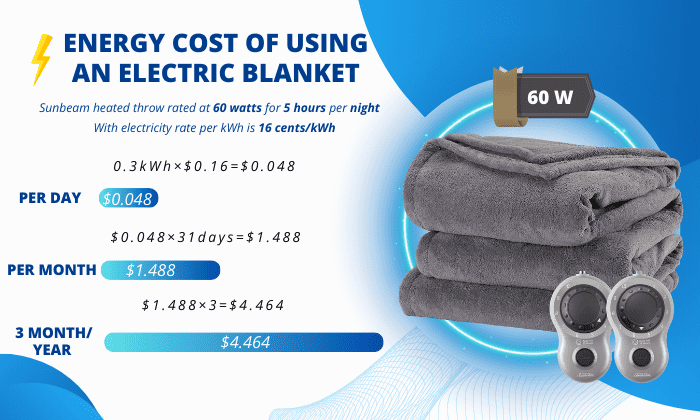Snuggling up with a warm, cozy electric blanket seems like a dream on a cold winter night. But that comforting heat comes with a cost—electricity usage. So how many watts does an electric blanket use exactly?
Electric blankets typically use 100-200 watts of power, or even more if conditions get more chilly in the winter months. I’ll break down the power draw and energy cost of using these heated bed accessories.
Table of Contents
How Much Electricity Does an Electric Blanket Use?
Watt Usage of Electric Blankets Based on Brand
The wattage used by an electric blanket depends on the size and brand. Most standard electric blankets draw around 100 watts on the highest heat setting.
However, wattage can range from as low as 50 watts on certain blankets up to 200 watts on larger premium products.
While electric blanket wattage is rarely revealed by the company, I dived deeper and came up with the following values:
| Electric Blanket Brand | Wattage Rating |
| Serta | 100W to 200W |
| Biddeford Blankets | 130W |
| Sunbeam Blankets | 120W |
| Pure Warmth Blankets | 130W to 150W |
| Beautyrest Blankets | 180W |
| Woolrich (King, Queen Size) | 280W |
| Woolrich (Twin Size) | 140W |
Admittedly, these are only values from specific products of the said brands.
These numbers rarely stay static as well, since wattage depends on other important factors such as the setting and season, which impact how many watts the blanket needs to pull to manage colder environments and overall energy usage.
Electric Blanket Wattage by Setting
Most electric blankets today have at least a high, medium, and low option. Usually, the power draw shifts based on the blanket’s temperature setting. Here’s a table that gives you an idea about the wattage ranges to expect based on the blanket’s active setting.
| Setting | Power Range |
| Low | ~50-100W |
| Medium | ~100-150W |
| High | ~150-200W+ |
One Reddit discussion had the original poster share real-world data from actual testing. They mention that, on a heat setting of 4 out of 10, the electric blanket pulled a total of 280 watt-hours overnight (over 8 hours).
That’s a very low wattage electric blanket, considering the values I’ve mentioned previously. Ultimately, you have to know the total watts consumed overnight if you really want to know the exact consumption.
If, let’s say, you use the Biddeford blanket mentioned above for 6 hours, then it will likely consume 780Wh for that entire duration and within a single night.
Electric Blanket Wattage by Season
Blanket settings and run times impact consumption based on seasonal needs as well. During especially cold winter nights of 30 degrees or below, I’ll use my electric blanket on high the whole night for 10-hour stretches.
However, on cool 50-degree autumn evenings or as an extra boost to the spring AC setting, low or medium for just 8 hours does the trick.
Here’s a breakdown of what I researched when it comes to electric blanket wattage by season:
- Summer: 50-100W (low settings)
- Spring/Fall: 100-150W (medium settings)
- Winter: 150-200W+ (high settings)
- Extreme cold: 200W+ (highest settings)
In warmer weather, lower settings around 50-100W are usually sufficient. In cold winter conditions, the high settings of 150W or more provide more heating power. The wattage required depends on the ambient temperature and personal preference.
Energy Cost of Using an Electric Blanket
The following formula calculates the daily usage cost of an electric blanket. It works by:
- Taking the wattage of the electric blanket (e.g. 150W)
- Multiplying by the number of hours used per day (e.g. 6 hours) to get the total watt-hours (900 Wh)
- Converting the watt-hours to kilowatt-hours (kWh) by dividing by 1000 (900 Wh/1000 = 0.9 kWh)
- Finally, multiplying the kWh usage by the electricity rate, usually in cents/kWh (e.g. 16 cents/kWh) to get the daily cost
Let’s break down how to estimate the operating costs of an electric blanket with some easy formulas.
- First, calculate the blanket’s hourly electricity usage in kilowatt-hours (kWh):
Blanket Wattage x Hours Used ÷ 1000 = kWh
As an example, if I use my Sunbeam heated throw rated at 60 watts for 5 hours per night, I will consume:
\[60 \, \text{W} \times 5 \, \text{hours} = 300 \, \text{Wh} \, (\text{watt hours})\]
\[\frac{300 \, \text{Wh}}{1000} = 0.3 \, \text{kWh}\]
Therefore, running my 60-watt blanket for 5 hours draws 0.3 kWh.
- Next, factor in your electricity rate per kWh, usually priced in cents. The national average is around 16 cents/kWh
Daily Usage Cost = kWh x Electricity Rate
Sticking with the same figures, that’s: \[0.3 \, \text{kWh} \times \$0.16 \, \text{per kWh} = \$0.048 \, \text{per day}\]
- This scales up simply for monthly and yearly totals too:
Monthly Cost = Daily cost x Days used
Yearly Cost = Monthly cost x 12 months (or Months used)
If I use my electric blanket every night during December, that’s 31 days:
\[\$0.048 \, \text{per day} \times 31 \, \text{days} = \$1.488 \, \text{per month}\]
And for annual occasional use, say 90 days or 3 months a year:
\[\$1.488 \, \text{per month} \times 3 = \$4.464 \, \text{per year}\]
Running through these quick calculations before ever switching on your electric blanket can set reasonable expectations for energy costs and usage.
I admit that I estimated loose figures here, but actual costs vary depending on blanket efficiency, settings, your electricity rates, and length of use.
Conclusion
The wattage drawn by an electric blanket depends on factors like size, brand, and settings – typically ranging from 50-200+ watts.
Choosing an efficiently-sized blanket combined with reasonable temperature settings based on seasonal needs results in optimal savings.
While I provided estimated costs based on sample usage, precise figures vary. With some simple math and informed use, you’ll always be able to know the exact answer to “How many watts does an electric blanket use?”

I am Andrew Wright. With 8 years of experience designing, installing, and maintaining electrical power systems. I love my job, and I have always wanted to offer others the necessary help so they can take care of their houses.

